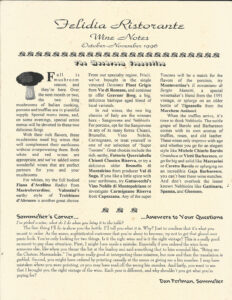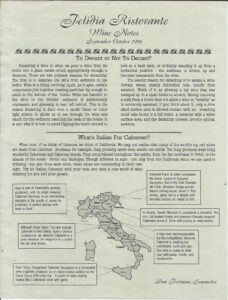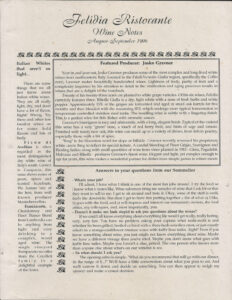Wine Notes – October-November 1996
 Felidia Ristorante
Felidia Ristorante
Wine Notes
October-November 1996
The Mushroom Connection
Fall is mushroom season, and they’re here. Over the next month or two, the two king mushrooms of Italian cooking, porcinis and truffles, are in plentiful supply. Special menu items, and, on some evenings, special entire menus will be devoted to these two delicious fungi.
With their rich flavors, these mushrooms need big wines that will complement their earthiness without overpowering them. Both white and red wines are appropriate, and we’ve added some wonderful wines that are perfect partners for you and your mushrooms.
For whites, try the full bodied Fiano d’Avellino Radici from Mastroberardino; Valentini’s earthy style of Trebbiano d’Abruzzo is another great choice. From our specialty region, Friuli, we’ve brought in the single vineyard Dessimis Pinot Grigio from Vie di Romans, and continue to offer Gravner Breg, a big, delicious barrique aged blend of local varietals.
In red wines, the two big classics of Italy are the winners here – Sangiovese and Nebbiolo. For porcinis, opt for the Sangiovese in any of its many forms: Chianti, Brunello, Vino Nobile, Carmignano, or treat yourself to one of our selection of “Super Tuscans”. Great choices include the ric, earthy, Fattoria Querciabella Chianti Classico Riserva, or try a delicious older Brunello di Montalcino from producer Val di Suga. If you like a little spice with your earthiness, try Gattavecchi’s Vino Nobile di Montepulciano or investigate Carmignano Riserva from Capezzana. Any of the super Tuscans will be a match for the flavors of the porcinis, try Montevertine’s Il novantuno di Sergio Manetti, a special winemaker’s blend from the 1991 vintage, or splurge on an older bottle of Tignanello from the Marchese Antinori.
When the truffles arrive, it’s time to think Nebbiolo. The noble grape of Barolo and Barbaresco comes with its own aromas of truffles, roses, and old leather. These wines only improve wiht age and whether you go for an elegant style like Michele Chiarlo Barolo Granduca or Vietti Barbaresco, or go for big and solid like Marcarini or Ceretto Barolo or splurging on an incredible Gaja Barbaresco, you can’t beat these wine matches. And don’t overlook the lesser known Nebbiolos like Gattinara, Spanna, and Ghemme.
℘℘℘
Sommelier’s Corner … Answer to Your Questions
I’ve picked a wine, what do I do when you bring it to the table?
The first thing I’ll do is show you the bottle. I’ll tell you what it is. Why? Just to confirm that it’s what you meant to order. As the suave, sophisticated customer that you’re about to become, try not to get that glazed over panic look. You’re only looking for two things. Is it the right wine and is it the right vintage? This is a really good moment to pay close attention. First, I might have made a mistake. Especially if you ordered the wine from someone else, like when you thrust the list at the busboy and said something that to him sounded like, “Bring me the Chateau Marmaduke.” I’ve gotten really good at interpreting these missives, but now and then the translation is garbled. Second, you might have ordered by pointing casually at the menu or giving me a bin number. I may have mistaken where you were pointing, or you may have read off the wrong bin number. And lastly, you want to that I brought you the right vintage of the wine. Each year is different, and why shouldn’t you get what you’re paying for?

